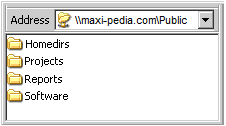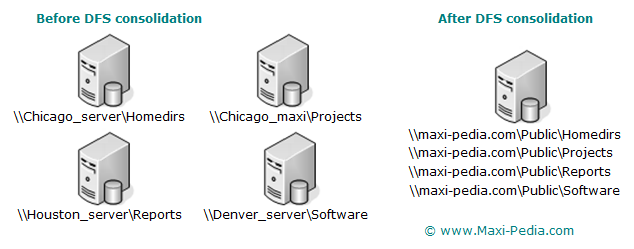What is DFS (Distributed File System)
What is DFS (Distributed File System)
What is DFS you ask today. DFS stands for Distributed File System and is a technology in the Microsoft shop related to sharing files across networks, specifically across wide area networks.
What is DFS is the question every network administrator asks when a boss on one side of the state calls him asking how he can get access to a shared network folder on the other side of the state.
What is DFS
So, what is DFS? Let's approach answering this question by providing an example. You have two computers, one in one room, and the other in the other room. They are connected through a cable. If you want to exchange files between these two computers, you can share a folder on computer A and then simply navigate to the shared folder from computer B. This solution will work fine on a small network where you do not need to worry much about permissions, accessibility constraints, performance, reliability, and distance.
If you expand your network into a business network with many users (but let's say still in the same building), you will need something more advanced. Your option in this case would be to create a shared folder on your computer and then publish it to Active Directory. Your users will be able to search and access your shared folder easily through Windows Explorer and you will be able to set permissions. See here for more details: How to publish shared folder in Active Directory.
What if your business and network grows into a large scale distributed network with offices in various cities? You deal with distance, you deal with permissions, and you perhaps deal with having way too many shared folders in your network. In this case, you need something more robust. You need DFS (Distributed File System) and you start asking What is DFS.
So, what is DFS in real world?
DFS is a mechanism for sharing files, but it is much more intelligent than a simple sharing that we have described above.
Consolidation of file shares (DFS)
Distributed file system (DFS) is used to make files distributed across multiple servers appear to users as if they reside in one place on the network. In other words, DFS allows administrators to consolidate file shares that may exist on multiple servers to appear as though they all live in the same location so that users can access them from a single point on the network.
Let's take a look at an example. The following picture shows what a user may see when browsing to a corporate shared location called Public. Public is what the user calls a shared network folder.

What the user does not know is that each of these "folders" inside the Public folder is a shared folder located on its own file server. For example, the Homedirs folder is a shared folder located in Chicago. Projects is another shared folder located also in Chicago but on another server. Reports is another DFS shared folder located in Houston. Software is a shared folder out of Denver. Using DFS, you can consolidate all these shares into one logical DFS view which will appear to the network users as though all the shares are in one location.

DFS provides a mechanism for administrators to create logical views of folders and files, regardless of where those files are physically located on the network. The Public folder is what we call a DFS root.
DFS replication across WAN
Starting with Windows Server 2003, DFS includes WAN (Wide Area Network) replication which means that DFS points can exist across WAN links. This means that your network administrator has the ability to replicate DFS roots and shared folders to multiple servers in the domain. By doing so users are permitted to obtain access to their files even if one of the physical servers on which the files reside becomes unavailable. So, DFS brings a great benefit in terms of fault tolerance.Ease of use (DFS user perspective)
Before DFS, when you shared a folder on your computer, the user on the other side of the cable needed to know the actual physical location of your shared files and folders in order to obtain access to them. DFS can be implemented as stand-alone or domain-based. If you implement DFS as domain-based, you gain a great advantage which makes searching for your files very easy. Domain-based DFS automatically publishes the DFS topology in the Active Directory and makes it visible to users on all servers in the domain. Your users no longer need to know the physical location of your shared folders and files because they can just browse to the resource in the domain tree using their Explorer.
What are the benefits of DFS?
When asking What is DFS, we naturally ask about the benefits. Many of them are obvious from the explanation provided above, but below is a list of benefits.
- Resources management and accessibility (users access all resources through a single point)
- Accessibility (users do not need to know the physical location of the shared folder, then can navigate to it through Explorer and domain tree)
- Fault tolerance (shares can be replicated, so if the server in Chicago goes down, resources still will be available to users)
- Work load management (DFS allows administrators to distribute shared folders and workloads across several servers for more efficient network and server resources use)
And many others.
What is DFS root and how do I create one?
You can read more about DFS root here: What is DFS root and how to create one.
You are welcome to read about the difference between a shared folder and DFS root here: Difference between shared folder and DFS.
It is easy, just include the code provided below into your HTML code.
 Delicious
Delicious Digg
Digg StumbleUpon
StumbleUpon Furl
Furl Facebook
Facebook Google
Google Yahoo
Yahoo

